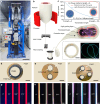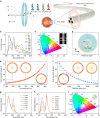Wearable and interactive multicolored photochromic fiber display
- PMID: 38355692
- PMCID: PMC10866970
- DOI: 10.1038/s41377-024-01383-8
Wearable and interactive multicolored photochromic fiber display
Abstract
Endowing flexible and adaptable fiber devices with light-emitting capabilities has the potential to revolutionize the current design philosophy of intelligent, wearable interactive devices. However, significant challenges remain in developing fiber devices when it comes to achieving uniform and customizable light effects while utilizing lightweight hardware. Here, we introduce a mass-produced, wearable, and interactive photochromic fiber that provides uniform multicolored light control. We designed independent waveguides inside the fiber to maintain total internal reflection of light as it traverses the fiber. The impact of excessive light leakage on the overall illuminance can be reduced by utilizing the saturable absorption effect of fluorescent materials to ensure light emission uniformity along the transmission direction. In addition, we coupled various fluorescent composite materials inside the fiber to achieve artificially controllable spectral radiation of multiple color systems in a single fiber. We prepared fibers on mass-produced kilometer-long using the thermal drawing method. The fibers can be directly integrated into daily wearable devices or clothing in various patterns and combined with other signal input components to control and display patterns as needed. This work provides a new perspective and inspiration to the existing field of fiber display interaction, paving the way for future human-machine integration.
© 2024. The Author(s).
Conflict of interest statement
The authors declare no competing interests.
Figures




References
-
- Qu CM, et al. Multifunctional displays and sensing platforms for the future: a review on flexible alternating current electroluminescence devices. ACS Appl. Electron. Mater. 2021;3:5188–5210. doi: 10.1021/acsaelm.1c00833. - DOI
-
- Zuo Y, et al. Flexible color-tunable electroluminescent devices by designing dielectric-distinguishing double-stacked emissive layers. Adv. Funct. Mater. 2020;30:2005200. doi: 10.1002/adfm.202005200. - DOI
LinkOut - more resources
Full Text Sources

